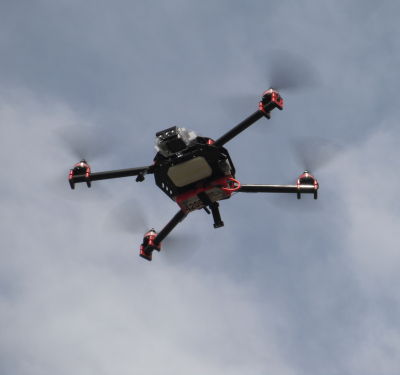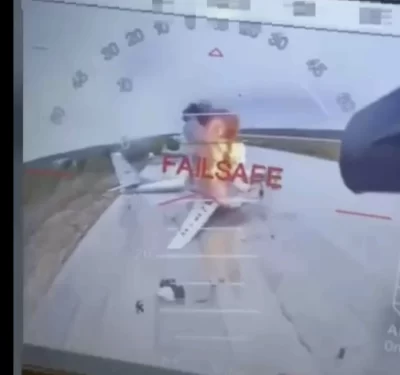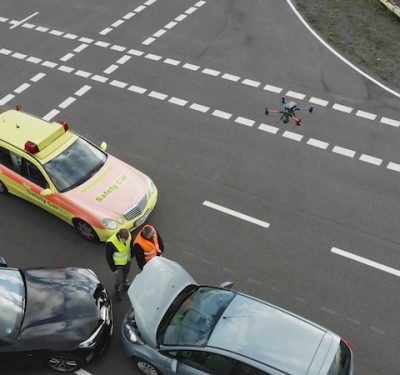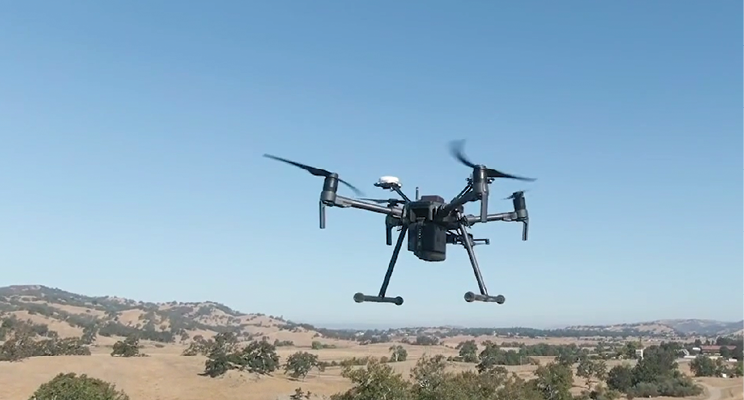
WhiteFox Defense’s Remote ID Module, known as WISDM, prevents intrusions.
New year, new remote identification (RID) rule. In some respects, the final rule looks a lot different from the Notice of Proposed Rulemaking (NPRM); in other ways, not so much. The saying goes, “Where you sit determines where you stand.” In the case of RID, how you fly—and who you are—does as well.
So, how does RID look, as it has evolved, through the lens of impacted stakeholders?
Service Suppliers
The main buzz about RID is that the end-of-year FAA “final rules for unmanned aircraft” scrapped network-based/internet transmission—and third-party UAS Service Suppliers (USS)—in favor of a broadcast-only solution. This is a huge turnabout from the NPRM version, which had incorporated a network/USS concept for what the FAA originally coined “standard” and “limited” RID drones.
The original standard RID drone was supposed to broadcast message elements (MEs—more on these later) directly and through the internet by way of these third-party USS, from takeoff to landing. Limited RID UAS would have been restricted to flying no more than 400 feet from a control station while transmitting RID MEs through the internet to a USS, without broadcast. The final rule jettisons the network requirement. It pivots standard RID to RF frequencies commonly used by personal communication devices. It completely discards limited RID and provides a “broadcast module,” a separate device attached to the drone to broadcast MEs, in lieu thereof. Like the former limited ID drones, broadcast module drones will need to remain within visual line of sight (VLOS).
Words matter. The FAA carefully chose its language to leave the door open for network and other tech options in the future. Take this nugget, for example, tucked away on page 79: “The FAA notes that this rule does not preclude industry from establishing Remote ID USS-like networks where entities can exchange remote identification information to facilitate a safer and more efficient airspace of the United States.” A careful read of the almost 500-page document reveals a consistent “more to follow” theme.
USS are surely posturing to move forward.
Drone Service Providers (DSP)/Operators
The purpose of the rule hasn’t changed: address safety, national security and law enforcement concerns to further integrate drones in the National Airspace System. Ironically, from the perspective of many DSPs, the rule encroaches on their own personal safety. It requires their UA to beam MEs out to the public and security agencies alike.
As originally proposed, MEs were to include:
• UAS identity: manufacturer-assigned serial number or USS-assigned Session ID (randomly-generated alphanumeric code assigned on a per-flight basis);
• control station latitude and longitude;
• AGL UAS latitude and longitude (standard RID only);
• control station and UAS barometric pressure altitude;
• coordinated Universal Time (UTC) mark;
• emergency status indicator.
Public access to the control station’s (read: operator’s) location raised vigilante justice concerns (reported in Inside Unmanned Systems previously: insideunmannedsystems.com/rid-somebodys-watching-me/). These concerns persist in the final rule. ME requirements are largely the same, with few exceptions. For standard ID, the control station will still be available to John Q Public. For broadcast modules, the MEs will include takeoff—not control station—location and they must continue beaming until shutdown—not upon landing. Thus, broadcast module users remain vulnerable because shutdown will likely occur where the drone took off, near the operator.
In addition to packing a potentially literal wallop for DSPs, there remains an unquantified hit to their wallets as well. While the removal of the network/USS requirement should decrease operator costs by eliminating USS subscription fees, this is offset by the cost of either buying a new standard-RID drone or retrofitting an existing one with a broadcast module. This technology is still in development and the cost is unknown.
Some DSPs previously raised privacy concerns because law enforcement officials (LEOs) and security agencies can triangulate MEs with FAA drone registration data. Nothing has changed here except, unlike in the NPRM, the FAA repeatedly emphasized its understanding that LEOs would adhere to “due process and other legal and constitutional requirements” (page 178).
Through the DSP lens, there is some very good news. The FAA simultaneously released the Operations Over People final rule, generally permitting routine operations over people (maybe), moving vehicles and night operations of SUAs. We previously outlined the nuances of this other new rule here: insideunmannedsystems.com/oops-there-it-is/. Individual Part 107 waivers will not be required for these ops. RID will be, for the majority of them.
Operators are standing by for the tech and time to comply with the rule.
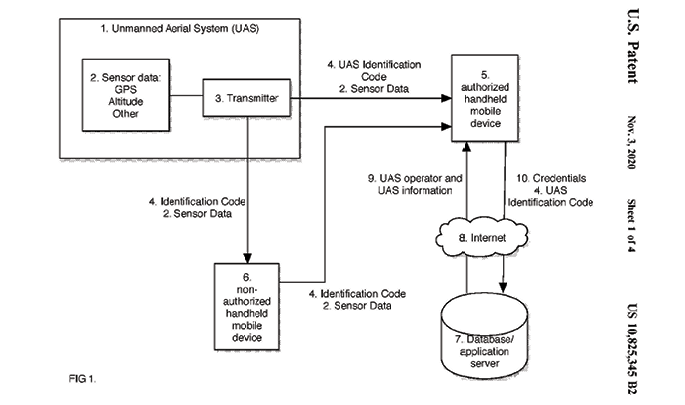
Security Agencies
The NPRM justified RID based on the need for federal security partners to have near real-time situational awareness of UAS flying in the U.S. In the final rule, the FAA beefed up this security rationale to include: time and cost savings for incident reporting/response/investigation, threat discrimination and analysis, incident response, interdiction, mitigation, oversight and, oddly enough, assisting in “enforcement of laws related to regulation of controlled substances.” (pages 23 and 415). Perhaps that last was a Homeland Security add.
Although RID exists in large part for LEOs, it nevertheless remains a tool they can choose to use or not. But right now, they cannot. One year post-NPRM, the technology for LEOs to triangulate RID MEs with FAA registration still does not exist. Even when tech arises, it remains unclear as to whether LEOs could afford it.
Is RID helpful from the LEO lens? A bit. But security experts, such as Travis Moran, strategic advisor for Welund, a physical security business risks consultancy, have stated that the RID rule—then and now—does not go far enough. Drone registration information does not include an operator’s social security number or date of birth, which are key to unlocking virtually every law enforcement database needed to get a picture of the operator’s profile and past criminal history (e.g., weapons charges or outstanding warrants). In the final rule, the FAA acknowledges this (page 188): “LEO databases are not linked into the FAA’s registration system. This rulemaking does not speak to the use of information by law enforcement agencies, or how remote identification data will be correlated with other law enforcement data.”
The devil is in the details, and there are plenty of details to sort out before LEOs can use RID consistent with its stated purposes.
Hobby/Recreational Users
The FAA revised a number of things for the hobby/rec crowd in the new rule. They switched up terminology from “amateur-built UAS” to “homebuilt UA.” Its definition changed, removing the requirement that the builder fabricate and assemble at least 50 percent of the drone. The final homebuilt definition is simply, “an unmanned aircraft that an individual built solely for education or recreation.”
The rule also reversed course on the original proposal to have recreational users register each drone individually, instead opting for a one-and-done approach that allows a remote pilot to register once and just add additional drones as she/he purchases them.
This good news is tempered by the continued relegation of those who want to operate without RID to operate only within a designated FAA-recognized identification area (FRIA). This is a carryover from the NPRM. Other than timelines, the only other change in this area is the addition of educational institutions to those that may now also apply for FRIAs. The FAA is also promising to make the FRIA approval process very responsive compared to its old process to approve model aircraft strips.
Needless to say, this group is upset. Some continue to rally to sue and overturn the rule (Race Day Quads v. FAA: www.gofundme.com/f/savefpv).
Foreign-Registered Drones
In the NPRM, folks operating foreign-registered civil UA in the U.S. were going to have to submit a notice of identification to the FAA containing personally identifiable information. This requirement is not quite the same as registration, but an equivalent means to correlate the drone to a responsible person. The change in the final rule was to clarify that only those who meet the standard or broadcast module RID criteria would need to do so; others could fly freely in a FRIA.
Designers
Design requirements have evolved from the original proposal to a greater level of specificity. Now a designer must show that the UA or broadcast module meets the performance requirements of an FAA-accepted means of compliance (MOC). Consensus standards for these MOC are not fully completed yet because the RID rule just came out. ASTM has a big head start on final consensus standards.
However, standard RID UA will have to be designed to: actually broadcast required MEs; offer UA and control station positional accuracy to within 100 feet of the true position, with 95 percent probability; have UA geometric altitude accuracy to within 150 feet of the true geometric altitude, with 95 percent probability (similar to commercial off-the-shelf position sources, such as GPS receivers); provide control station geometric altitude accuracy to within 15 feet of the true geometric altitude, with 95 percent probability (similar to E911 requirements); have a latency of no more than one second for the remote ID message set for standard RID UA; and feature a transmission rate of at least one message per second (1 hertz) as the minimum transmission rate for the RID MEs for standard RID UA.
The minimum performance requirements and ME performance requirements for RID broadcast modules are similar to those for standard RID UA. One of the differences is that the latter includes takeoff location as a ME instead of control station location. Other differences between the minimum performance requirements for standard RID UA and RID broadcast modules include removing the design requirement that the UA cannot take off if it fails the self-test or is not broadcasting the MEs. There are also changes to the interference considerations to accommodate use of broadcast modules on compatible types of UA, and adjustments to the accuracy requirement for the indication of the takeoff location geometric altitude.
To meet the minimum performance requirements established in this rule, the equipment must be capable of recording the geometric position and geometric altitude of the UA takeoff location for these indications with the same positional accuracy as standard RID equipment.
Designers are pivoting to comply.
Producers
When the assembly line is ready to roll, UA or broadcast module must be issued a serial number that complies with ANSI/CTA-2063-A and the UA or the broadcast module must display a label indicating it meets the requirements of part 89 in English in a legible, prominent and permanently affixed manner. UA and broadcast module producers also will be required to submit a declaration of compliance for both UA and broadcast module production to the FAA.
This declaration should contain, among other things, a statement that the person responsible for the production of the UA:
• can demonstrate that the UA or broadcast module was designed and produced to meet the minimum performance requirements of standard RID UA or broadcast modules by using an FAA-accepted means of compliance;
• will, upon request, allow the Administrator to inspect its facilities, technical data, and any UA or module;
• will perform independent audits on a recurring basis;
• will maintain product support and notification procedures to notify the public and the FAA of any defect or condition that causes the UA or module to no longer meet the Part 89 requirements;
• will use 47 CFR part 15-compliant radio frequency equipment, which is integrated into the UA without modification to its authorized radio frequency parameters.
These requirements apply to all UA being developed for use in the U.S., with limited exceptions:
• homebuilt unmanned aircraft;
• unmanned aircraft of the United States Government;
• unmanned aircraft that weigh 0.55 pounds or less on takeoff, including everything that is on board or otherwise attached to the aircraft;
• unmanned aircraft designed or produced exclusively for the purpose of aeronautical research or to show compliance with regulations.
Tech is needed to start cranking up production lines.
The General Public
The public likely cares little about this rule, even though it provides the accidental benefit of accessible MEs. The extent to which people seek out such access and how they will use the information at their disposal remains to be seen.
In fact, much remains to be seen. Publication of the rule does not equate to “mission accomplished.” There is work to be done: tech to be developed, glitches to be ironed out, more policies to be written. No matter where you stand, let’s acknowledge that it’s a start. And then let’s fly.


